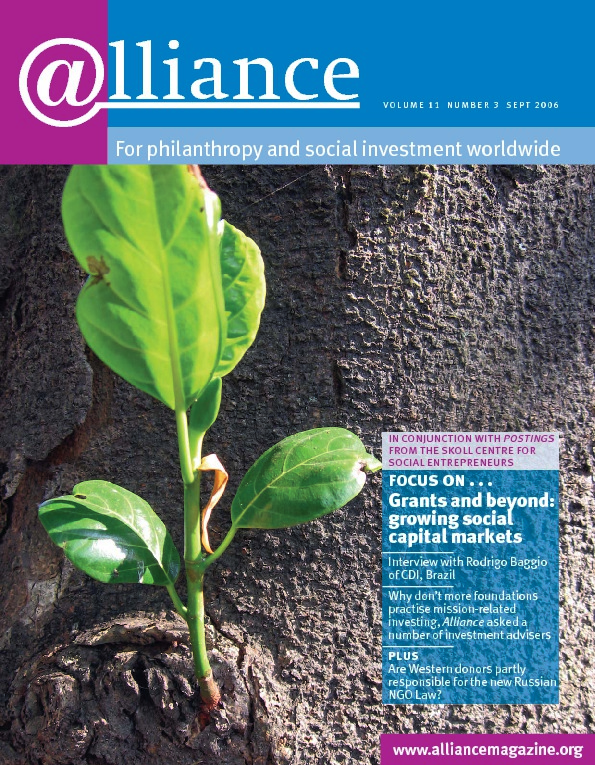‘Absolutely not!’ ‘No, I certainly would not include them.’ These are typical of the surprisingly forceful and unambiguous replies to the question, ‘is Justgiving a social enterprise?’ For those of you who have not heard of it, Justgiving is a privately held company that has become Europe’s largest online giving website. I was involved with the business from 2003 until this March (when I stepped down as Chairman), and in this capacity have put the question to several well-known experts from the social enterprise sector.
But consider. Justgiving will enable well over £70 million to find its way from donors to charitable causes this year. A substantial portion of this money would not have gone to charities otherwise. This financial impact places the company on a par with the UK’s largest charities, some of which are decades old, in contrast with Justgiving, which began in 2000. The firm employs an ethnically diverse staff, is run by two women (still unusual among businesses) and formally considers the broad spectrum of stakeholders (not only shareholders) in its actions. Beyond the cash it raises for charities, Justgiving helps them by promoting their message, reducing back-office costs, and boosting their online fundraising efforts.
The ownership question
There is, of course, a lack of agreement on what exactly constitutes a social enterprise. Is it what an enterprise does or does not do, where it does it, how it does it, why it does it, or who does it? Justgiving, according to the experts, stumbles on a different hurdle – how the company is owned. The disqualifying factor is that its investors may profit handsomely from its success. This, they believe, trumps any other consideration and is the quintessence of all that is wrong with our economic system.
In my own view, Justgiving is very much a social enterprise. And it may well be that its capital structure, which allows substantial wealth accumulation, has led it to be more successful than it would have been otherwise, and so to generate that much more in social benefits.
The saga of The Body Shop may be instructive. Commentators were outraged by their sell-out to L’Oreal. Yet, as I argued elsewhere (Guardian Unlimited, 30 June 2006), this event is in fact likely to be a substantial boost to social businesses. The sector is in need of commercial success stories which encourage other investors. And, given the history of the Roddicks, much of the £100 million plus heading into their hands is likely to wind up in social enterprises.
The growth of Justgiving
Justgiving has been very successful. Since 2003 the charitable flow has increased from approximately £2 million to an expected level of over £70 million in 2006. This astonishing growth rate has been matched in revenues, and a seven-digit loss is budgeted to become a seven-digit profit. In addition to becoming the dominant UK provider, Justgiving has expanded into the USA (a too-rare example of innovative business models moving westward), enjoying extraordinary growth there as well.
Close observers attribute Justgiving’s success to very easy use of the website, and Justgiving’s own research documents a high rate of customer satisfaction with its core product offering (an easy, quick and simple way to donate to charity over the internet). The company also benefits from a deep understanding of the customer experience and a clear knowledge of exactly who the customers are (the latter taking many years to refine). This high customer satisfaction and related ease of use is the result of ruthless examination and testing of every minute aspect of its offering. I have found this at Justgiving and other profit-seeking companies but rarely in enterprises where the wealth accumulation motive is absent.
As with all start-ups, effective cost control has been much in evidence. Furthermore, compared with other dotcoms, Justgiving frittered away little of its resources on wasteful mass marketing. The CEO is also an astute judge of which new initiatives represent fantastic opportunities and which will just eat up valuable time. This heightened sensitivity to waste and aggressive resource management is also typical of profit-seeking entrepreneurs I have observed. By contrast, I have found others in the charitable sector to be at times more relaxed about expenditure. Lastly, but perhaps most importantly, the CEO has selected an excellent team which complements her own considerable strengths very well.
Why for-profits might have an edge
CAFonline, which is part of the Charities Aid Foundation (CAF), operates in the same marketplace but has enjoyed far less growth. While detailed figures are not available, we have been told that since its inception, £29 million has been transacted through CAFonline accounts, in contrast with Justgiving’s total of £35 million in 2005 alone. Given the divergent growth rates, this gap is likely to increase.
Few would deny that CAFonline is a social enterprise and many would agree it has been successful. Yet the gap in performance between it and Justgiving is too great to ignore. Close observers of social enterprise thus need to address a fundamental question: is there something which profit-oriented models bring to the social enterprise sphere which may, in certain cases, create incremental social value? In raising this question I am assuming that more donations to charitable causes equal more social value. This is admittedly only one dimension of social value, but few would deny that more money to charity is better than less.
This is not to say that CAFonline does not make an important contribution as a social enterprise. Its goal is not to earn profits (CAF itself seeks to break even) but to increase funds going to the charitable sector and bring donors and charities together. In doing so, it works with more charities than Justgiving does (permitting access to approximately 220,000). CAFonline perhaps does so because of the social impact of such a service, which is consistent with its mission, and its ‘paid for’ services enable it to reinvest in free services for charities. Justgiving, with its different objectives, would not take on any clients that would be unlikely to enhance profitability overall.
Without going into the relative quality of the work the two organizations do, it is clear that the differences in their objectives result in different behaviour. The two organizations have different goals, perform different roles and generate different results. Both increase social value. Given the explicit objective of generating maximal growth in online charity giving, a worthy goal by most yardsticks, the Justgiving model appears to work better. Professionals with an interest in fostering social enterprise are doing the sector a disservice by excluding it from consideration.
Conclusion
Profit-seeking companies, of course, do not always grow faster or perform better. Bmycharity, another UK-based private company active in the sector, is substantially smaller, with £7 million in donations since its inception, although it was profitable before Justgiving. The US-based Kintera has far larger ambitions and resources than Justgiving but it has lost money consistently (in the first quarter of 2006 it reported a net loss of $9.3 million on revenues of $10.7 million). But none of this undermines the argument that the for-profit model can be an important producer of social benefit.
We in the UK social enterprise sector need to explore varied models to achieve our social objectives. By eliminating those that seek a profit we disadvantage the sector and discourage badly needed capital from entering. I think we should applaud successful fast-growth businesses like Justgiving, which also generate social value.
Rod Schwartz is CEO of venture capital firm Catalyst Fund Management & Research Ltd. In March he stood down as Chairman of JustGiving.com, in which he retains some stock options. Email rod@schwartzuk.com
Comment Filiz Bikmen
I whole-heartedly support Rod Schwartz’s proposal that for-profit initiatives should not be excluded from the realm of social enterprise simply because they share profits. Yet rather than launch deeper into the ‘to be or not to be a social enterprise’ debate, I’d like to consider how the expansion of online giving initiatives like Justgiving, whether for-profit or non-profit, will affect how we define and measure ‘success’.
The article suggests that for-profit enterprises may be more efficient and cost-conscious, better managed, and ultimately more successful than their non-profit counterparts. I think this assertion deserves a closer look, especially as we enter into an era where non-profits are increasingly challenged to be more transparent and accountable and to measure impact.
In addition, as The Economist (28 February) suggests, we are entering a ‘second golden age of philanthropy’ with the ‘birth of the philanthrocapitalist’ – referring to donors who are keen to move away from what they see as the static foundation model of the past and apply market approaches to their philanthropic endeavours.
With competition in donor services increasing, donor services and products will need to demonstrate quality, efficiency, and other ‘critical success factors’ in order to differentiate among themselves. Yet this is a big challenge, given the rather un-level playing field between non-profits and for-profits. Perhaps we need to define mutually applicable and objective ‘measures’ of success to enable us to compare and contrast different models. This may help lead us away from the arguably theoretical discussion of social enterprise definitions and more towards the practicalities which relate directly to both bottom lines.
Justgiving is a ‘success story’ that can inspire others. While I am excited about exploring market-based solutions, I am also cautious, keeping in mind an observation Warren Buffet shared with The Economist (1 July) that philanthropy aims to address problems that resist money and intellect and is therefore much more challenging than business.





Comments (0)